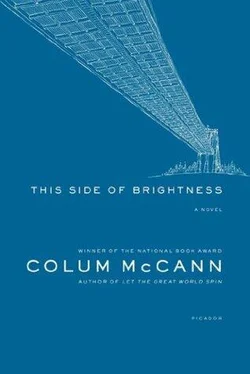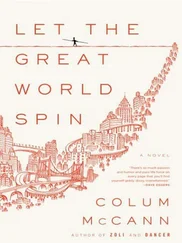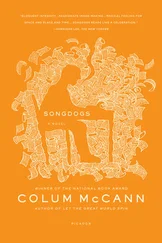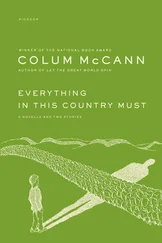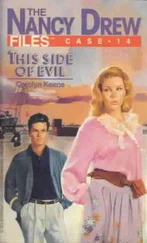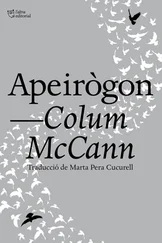She places her leg against the column, but the soles of her high heels are slippery and he must use all the strength of his forearms to haul her up. Her face is already bloated and bruised; there is blood from her mouth where a tooth has cracked; her eye is lacerated and bleeding. With one leg against the concrete column, she sobs. “Treefy.” Her arms flail and she breathes nervously. “I can’t do it. I can’t do it, Treefy.”
She seems to want to fall — it is only a few feet to the tunnel floor — but she stretches and catches hold of the crossbeam and his arms curl under her armpits. He leans dangerously over the beam and drags her up through the darkness until she is lying on the lowest beam, whimpering. He remembers lifting his daughter off the swing, and his stomach feels huge and hollow.
“Bring your legs across,” he says.
“Why don’t you—”
“Rest easy, Angela.”
“—have a goddamn ladder?”
He steps across her in one smooth movement and takes her hand in his. “I wanna get down,” she says.
“Stand up,” says Treefrog. “I got you, you won’t fall, I promise; you gotta trust me.”
“I don’t trust nobody.”
“Just try.”
“Nobody, I said.”
She remains with one leg on either side of the icy beam and her hands clasped at its edge. Her body begins quivering, so he leans down and puts his arms around her to warm her. He looks down at her high heels and says, “Wait a minute.”
And he is gone, twelve steps across, up to the next beam, into his nest and down again, holding some sneakers and three pair of socks. Treefrog hunkers down, removing Angela’s shoes.
“Here,” he says.
He flings her high heels all the way across the tracks toward the mural, and they land and roll in the patch of snow beneath the grill. “Stay still,” he says, and he pulls two sets of socks over her feet. He ties the sneakers — they are still way too big — and then tells her, “Now.”
Shoving the third set of socks into his pocket, he steps over her crouched form, stands behind her, lifts her up, and holds her waist.
“Treefy!”
“I got you.”
“It’s icy.”
This he recalls as he walks behind her: he arrives after dawn, a man in motion toward the sky. He climbs the steps from the subway station, walks down a street cantankerous with car horns. He is pinned in by businessmen and women on the way to Wall Street, but soon he joins other men, construction workers, who look as if they might have stepped out of advertisments for very strong cigarettes. Their eyes are bleary from nights of love and drink and television and cocaine. The back pockets of their jeans have taken on the logic of what they carry — the imprint of a pack of cigarettes, a small circle where tobacco tins jut, the bump of a plastic baggie of cocaine, the mark of a wallet. In the wallets they carry photos of their mothers and their wives and their girlfriends and their daughters and sometimes even their fathers and their sons. If they get hurt, it will be close to those they care about; it’s better to die close to family than to commerce. Still, death is seldom mentioned — even at funerals they say nothing about the way the dead man fell forty feet, or how the elevator shaft collapsed, or the attempted suicide that was caught by the net, or the single bolt that fell from up high and created a corridor of blood in a bricklayer’s head. Instead, they talk of women and girls and waitresses and the gentle curve of buttocks and flamboyant asses and the appearance of summer nipples and the way a shoulder is bared to sunlight.
They curse loudly as they move through the streets. They never give way. The businessmen seem small and useless and feminine around them.
Sometimes one of the workers puts a finger on one nostril and blows a stream of snot to the ground, and a businessman is disgusted and curls his upper lip, but the workers move on, indifferent, through the morning rush hour.
Clarence Nathan’s new tan construction boots have already been worn so much that rings of hair have been rubbed away where the leather uppers touch his legs. A talisman of sorts. A charm. His blue T-shirt clings tight to his torso. In the wallet in his back pocket he carries his grandfather, his dead mother, his wife, and his three-year-old daughter. His hair has fallen out of the Afro that Dancesca gave him, become long and straight once more. Up above, if he raises his head, a skeleton of his own creation rises toward a cloudless Manhattan sky. Some of his fellow workers will remain at the foot of the building, slinging chokers; others will hang clips to ropes and lean out dangerously over the middle section of steel; others will reside all day in its corridors, fixing elevator shafts, twisting electric wires, grouting, hammering, painting, sheet-rocking. But Clarence Nathan will go higher than any other walking man in Manhattan.
After coffee in the shanty, he joins the ironworkers at the elevator and they rise, aristocratic, in the air. Fourteen men, two teams of seven. The cage rocks in the wind. There are no glass panes, just bars across their knees, hips, chests. Beneath him, Manhattan becomes a blur of moving yellow taxis and dark silhouettes. There is something in this rising akin to desire, the gentle rock from side to side, the cooling breeze, the knowledge that he is the one who will pierce the virginity of space where the steel hits the sky.
All Clarence Nathan’s colleagues are sinewy. A couple of them are Mohawks, their blood distributed in such a way that it is balanced in all parts of their bodies: it comes from their history, it is a gift, they have pure equilibrium, the idea of falling is anathema to them. Others are from the West Indies and Grenada, and there is one Englishman, Cricket, who serves his vowels as if holding them out on a set of tongs. He is thin and blond and pockmarked and wears a lightning-bolt earring. Cricket was given his nickname for trying to teach the other workers his native game while standing at the top of a crossbeam. After shining an imaginary ball at his crotch, he put his head down, ran along the narrow beam to display the technique of bowling, making his arm spin in a giant circle. His watchers sat and stared as Cricket almost fell — there was thirty feet of space beneath him to metal decking — but he caught himself by the strength of his arms, dangled, grinned, pulled himself up, and said, “Leg before wicket, gentlemen!”
The elevator clangs and stops. Clarence Nathan finishes his coffee, tosses the paper cup, and walks across the metal decking toward two ladders that jut up in the air. For a joke the men call this area the POST, the Place of Shriveled Testicles. No ordinary man will go further.
The nimblest — Clarence Nathan and Cricket — take the ladder two rungs at a time. Their leather belts are filled with tools, and their long spud wrenches knock against their thighs. They climb three ladders to the very top of the building, where columns of steel reach up into the air. The foreman, Lafayette, in thick-rimmed spectacles, pokes his head up from the top of the ladder and says, “Another day, another dollar.”
Careful with how he steps, Lafayette walks across the loose decking. Cricket goes with him, saying, “Another day, another dolor.”
Clarence Nathan remembers his mental maps of yesterday: where certain pieces of equipment were left, where the holes in the decking might be, where on the roof he might accidentally kick over a bucket of bolts, where a can of beer might have been discarded at the end of the last shift. Radios crackle and voices babble over the airwaves. The men watch the huge yellow Favco cranes swing into action, bringing up beams and columns of steel. The metal is inched through the air. When the steel is laid on the decking, Lafayette decides in what order the men will build. The ironworkers wait and chat.
Читать дальше
